OvisLink WL5470POE Multi-function Wireless Access Point User Manual AirLive WL 5470PoE Manual
OvisLink Corp. Multi-function Wireless Access Point AirLive WL 5470PoE Manual
OvisLink >
Contents
- 1. User Manual
- 2. User Manual II
- 3. User Manual III
User Manual II
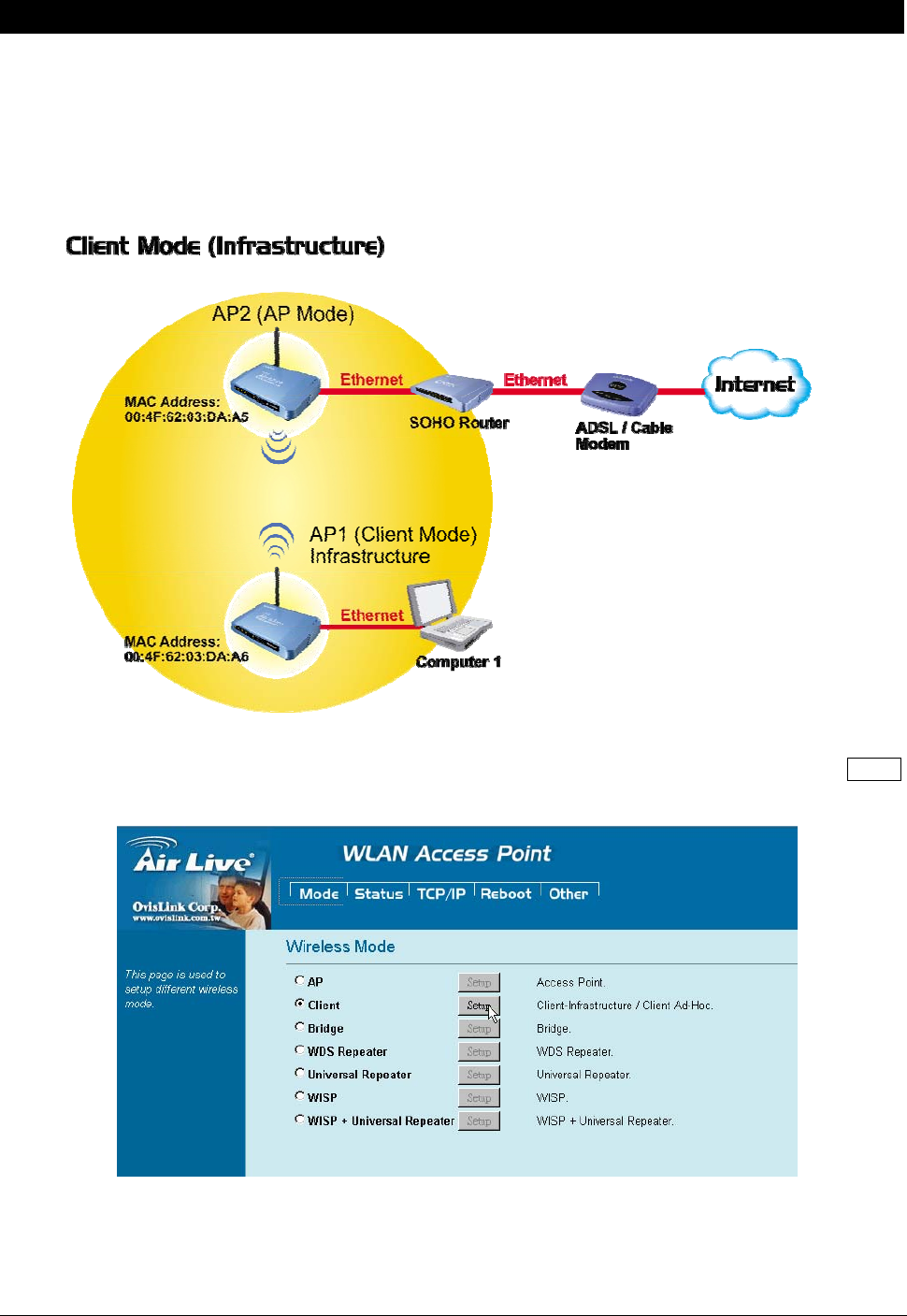
9 AirLive WL-5470POE User’s Manual
Client Mode (Infrastructure)
If set to Client (Infrastructure) mode, this device can work like a wireless station when it’s connected to a
computer so that the computer can send packets from wired end to wireless interface.
Refer to the illustration below. This station (AP1 plus the connected computer 1) can associate to another
Access Point (AP2), and then can have the Internet access if the other Access Point (AP2) has the Internet
connection.
To set the operation mode to “Client (Infrastructure)”, Please go to “Mode JClient” and click the Setup
button.
-
In the “Network Type” field, select as “infrastructure” for configuration.
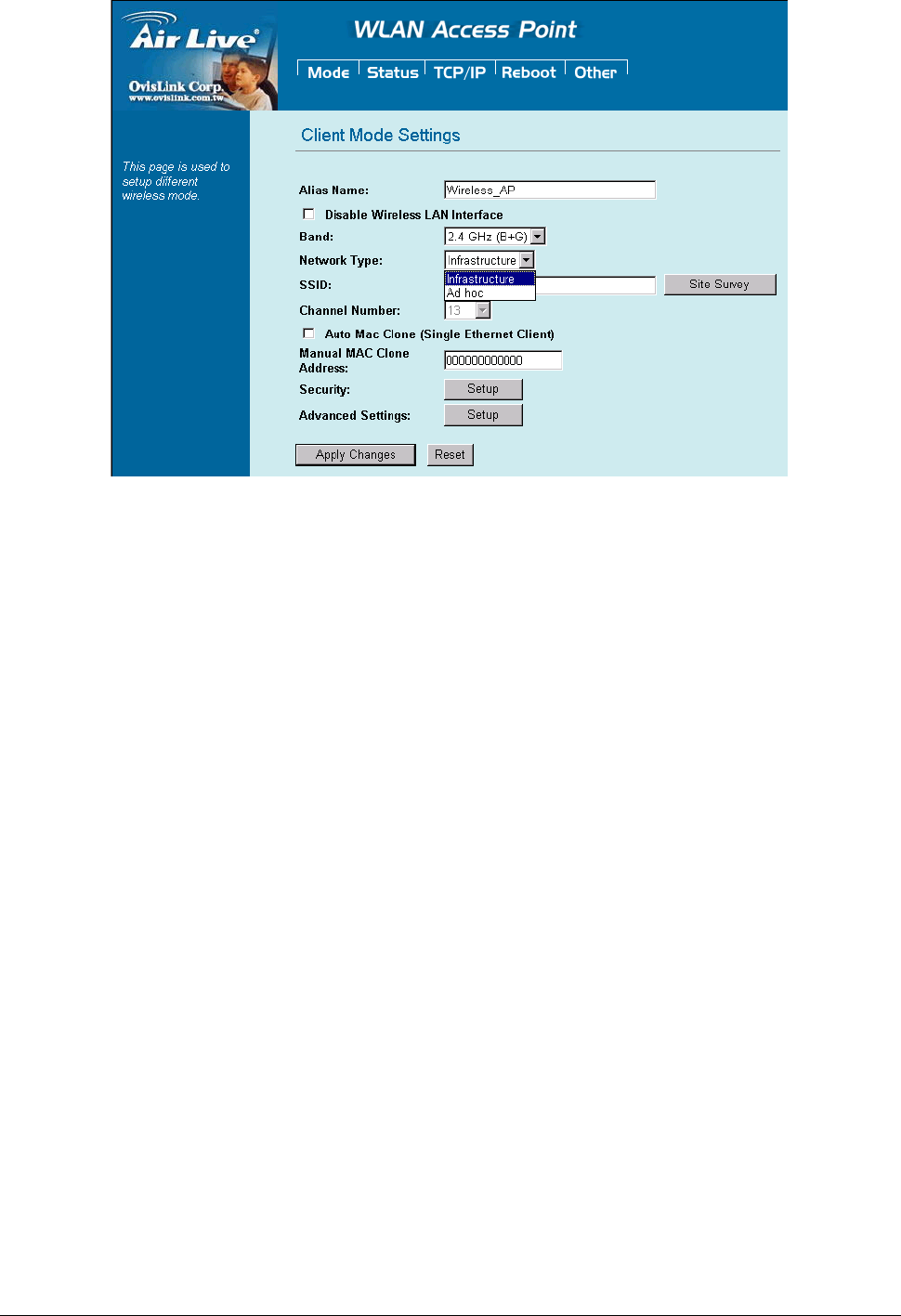
10 AirLive WL-5470POE User’s Manual
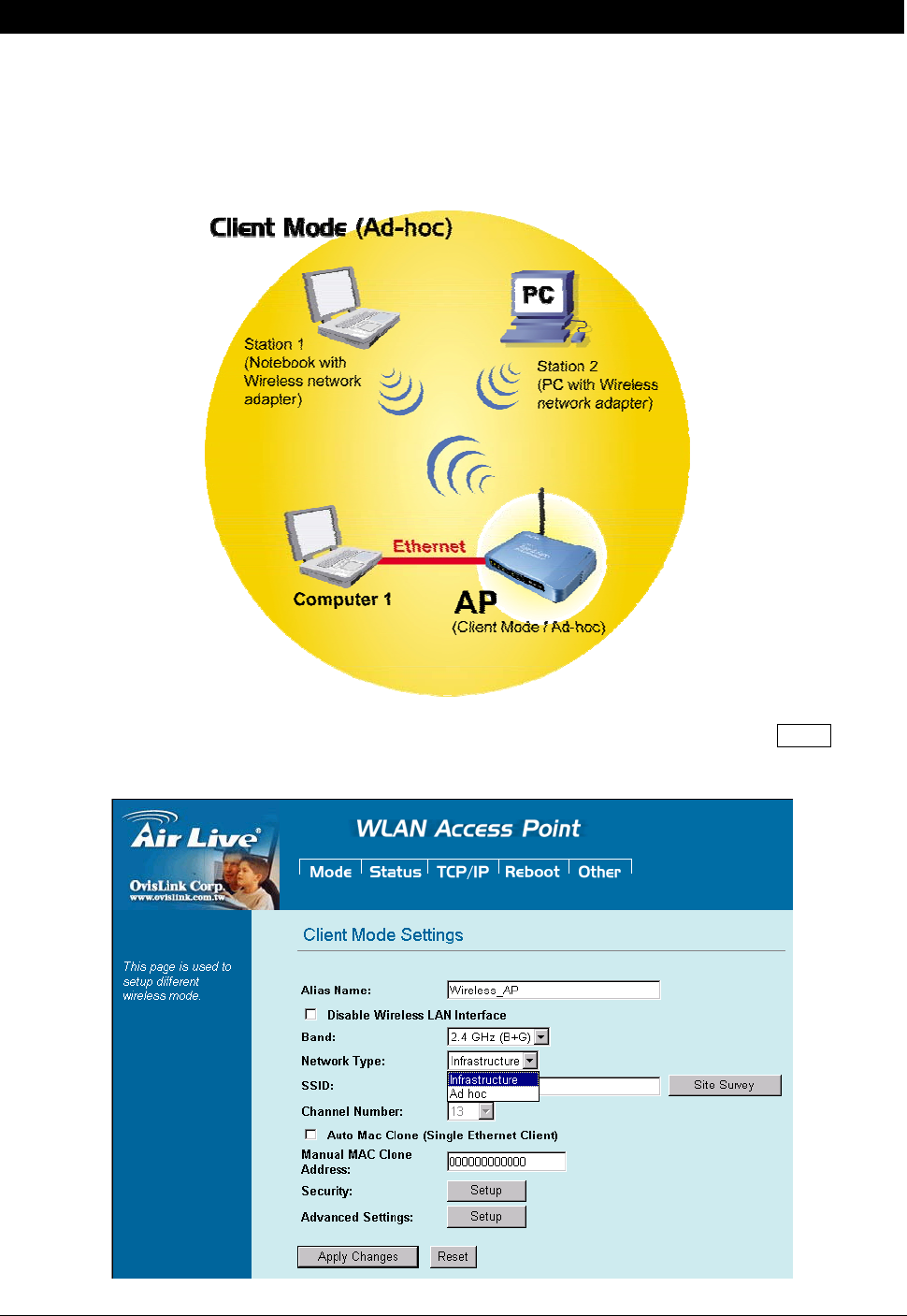
11 AirLive WL-5470POE User’s Manual
Client Mode (Ad-hoc)
If set to the Client (Ad-hoc) mode, this device can work like a wireless station when it is connected to a
computer so that the computer can send packets from wired end to wireless interface. You can share files
and printers between wireless stations (PC and laptop with wireless network adapter installed).
See the sample application below.
To set the operation mode to “Client (Ad-Hoc)”, Please go to “Mode JClient” and click the Setup button.
In the “Network Type” field, select as “Ad hoc” for configuration.
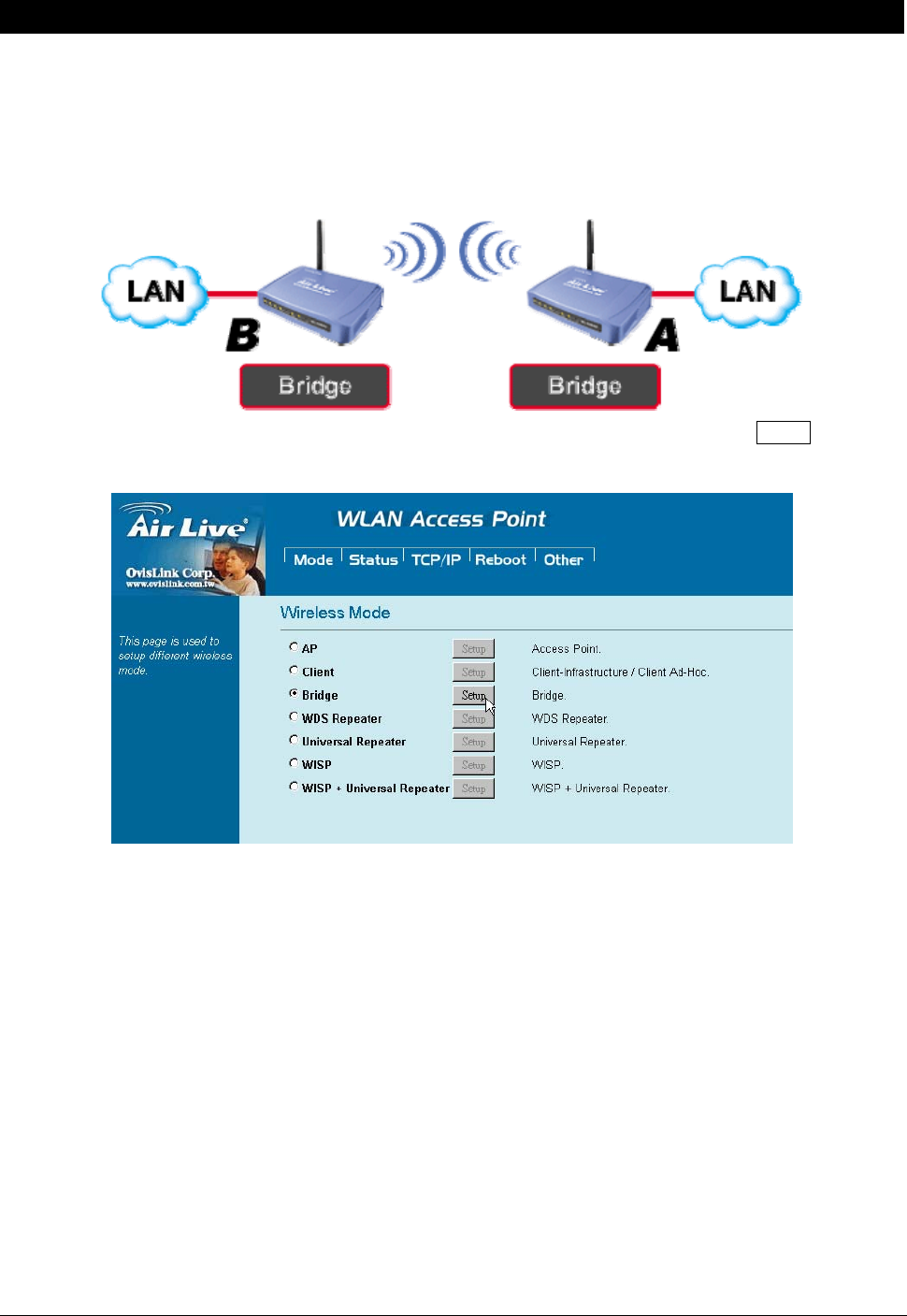
12 AirLive WL-5470POE User’s Manual
Bridge Mode
In this mode, 2 access points in two remote locations connect to each other to provide a wireless bridge
between 2 remote LANs. It is mostly used by enterprise to connect 2 remote office's network together. The
bridge modes are connected by using either the WDS (Wireless Distribution System) or Ad-Hoc topology.
This feature is also useful when users want to bridge networks between buildings where it is impossible to
deploy network cable connections between these buildings.
To set the operation mode to “Bridge”, Please go to “Mode JBridge” and click the Setup button for
configuration.
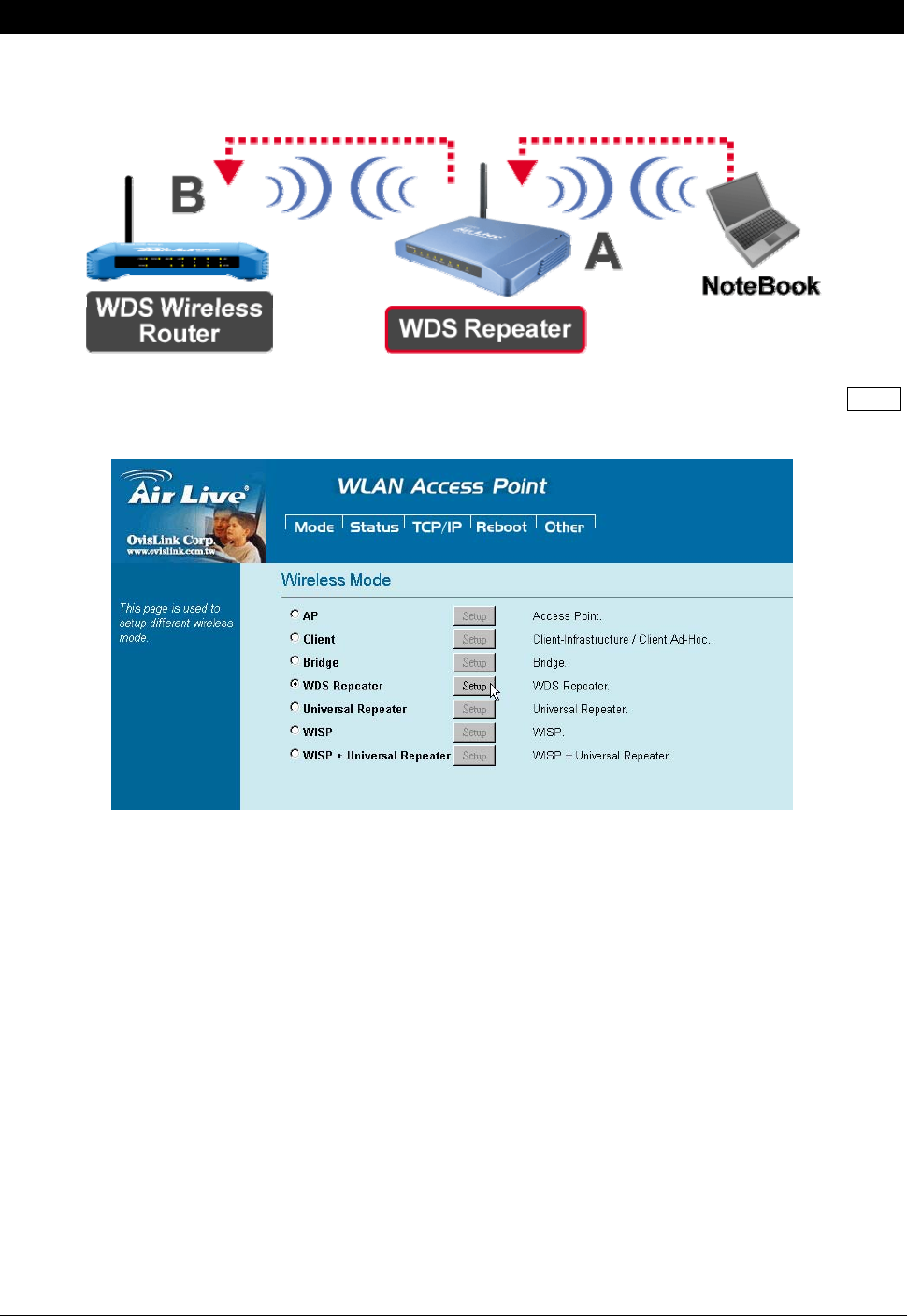
13 AirLive WL-5470POE User’s Manual
WDS Repeater Mode
A repeater's function is to extend the wireless coverage of another wireless AP or router.
For WDS repeater to work, the remote wireless AP/Router must also support WDS function.
To set the operation mode to “WDS Repeater”, Please go to “Mode JWDS Repeater” and click the Setup
button for configuration.
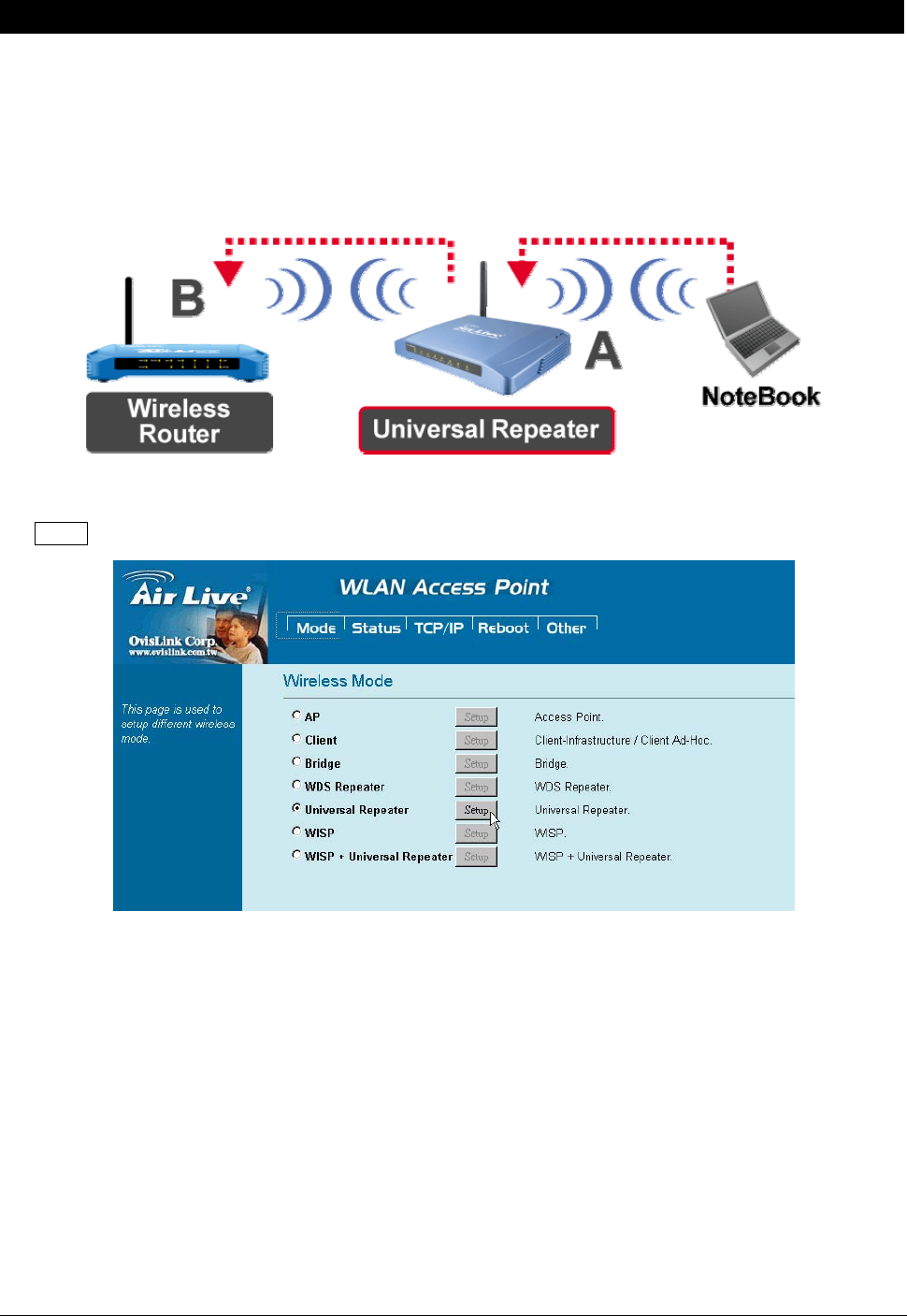
14 AirLive WL-5470POE User’s Manual
Universal Repeater Mode
A universal repeater can also extend the wireless coverage of another wireless AP or router. But the
universal repeater does not require the remote device to have WDS function. Therefore, it can work with
almost any wireless device.
Note: When you are using the universal repeater mode, please make sure the remote AP/Router‘s WDS
function is turned off.
To set the operation mode to “Universal Repeater”, Please go to “Mode JUniversal Repeater” and click
the Setup button for configuration.
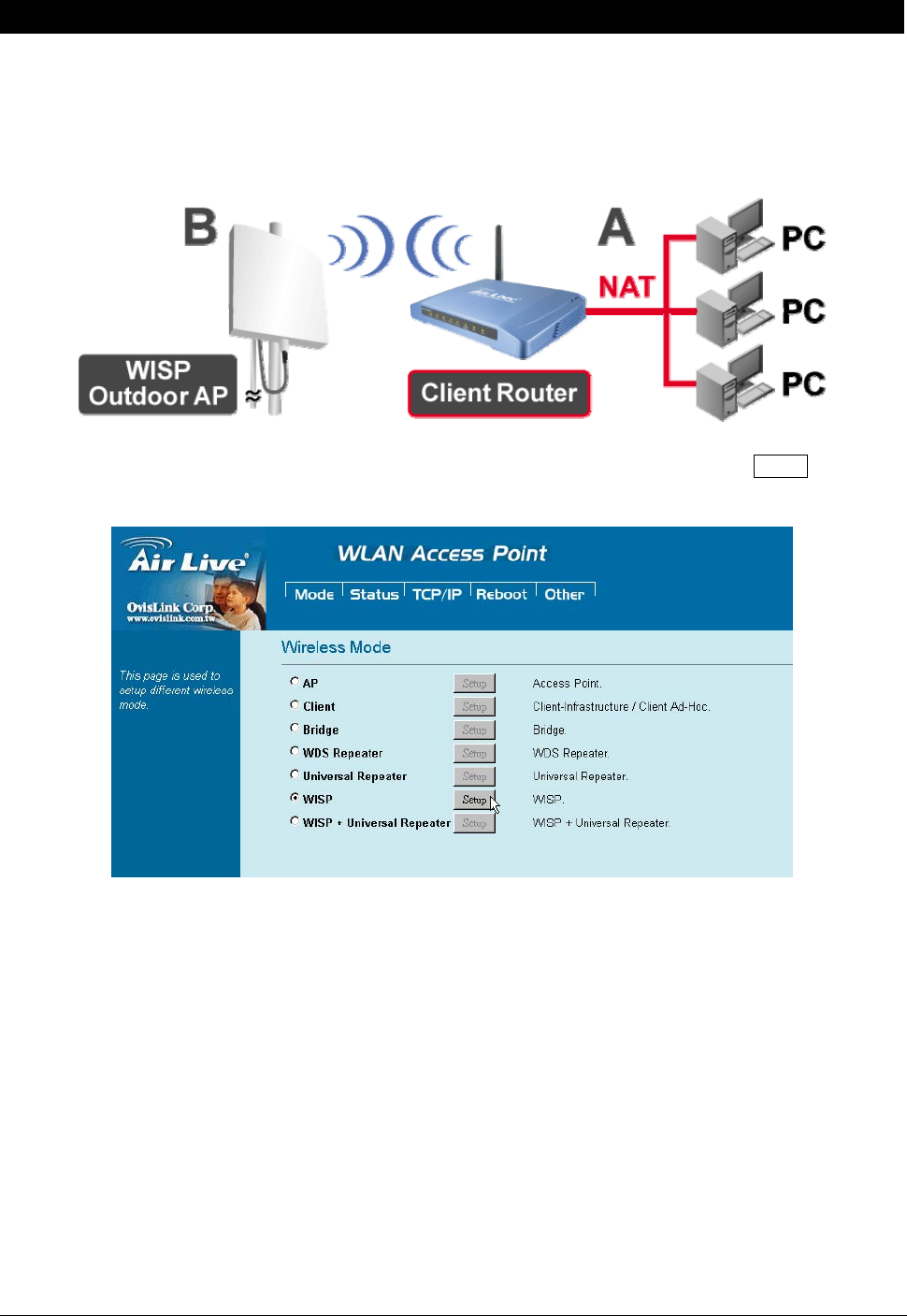
15 AirLive WL-5470POE User’s Manual
WISP ( Client Router) Mode
WISP (Client Router) mode
In WISP mode, the AP will behave just the same as the Client mode for wireless function. However, Router
functions are added between the wireless WAN side and the Ethernet LAN side. Therefore, The WISP
subscriber can share the WISP connection without the need for extra router.
To set the operation mode to “WISP”, Please go to “Mode JWISP” and click the Setup button for
configuration.
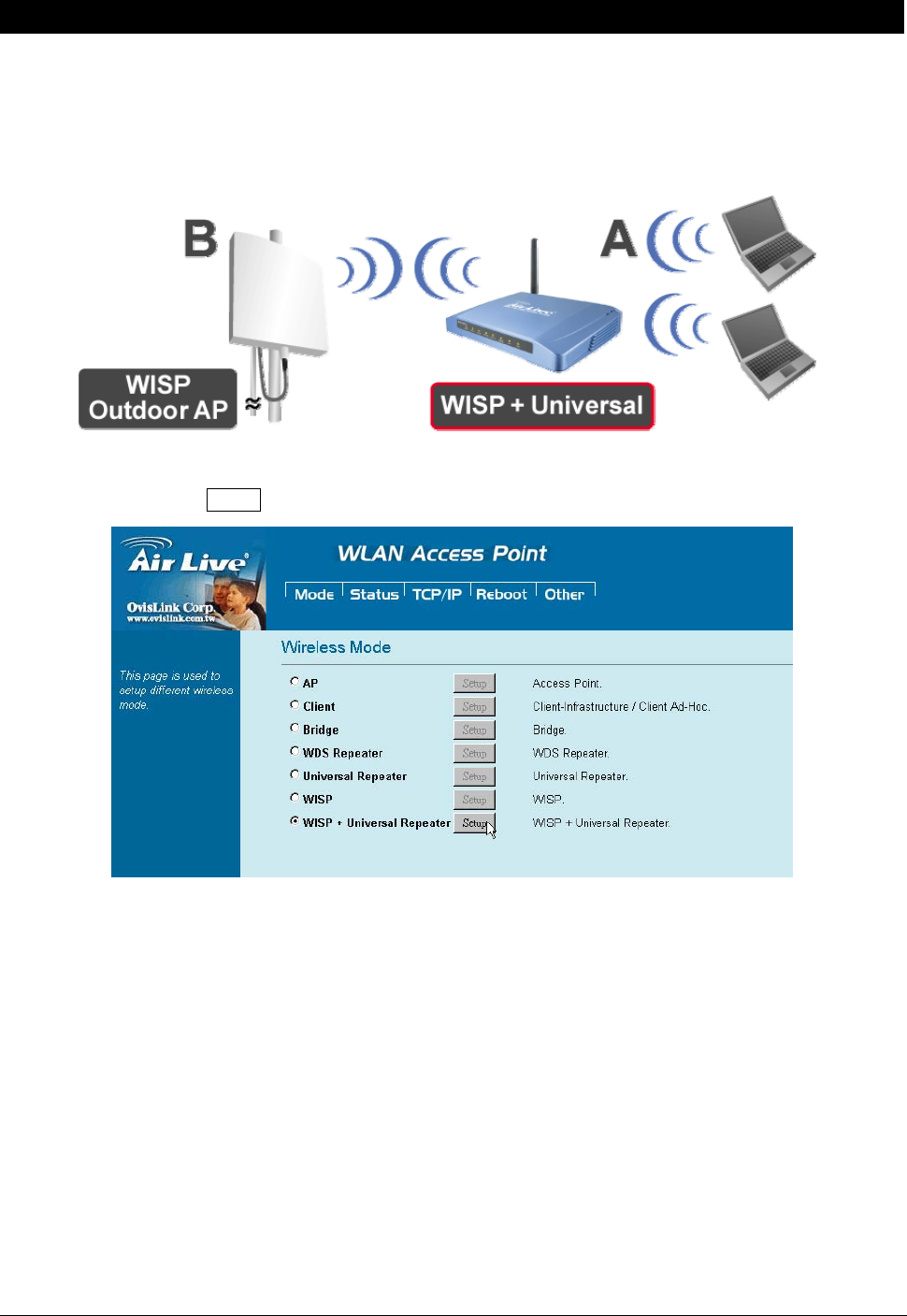
16 AirLive WL-5470POE User’s Manual
WISP + Universal Repeater Mode
In this mode, the AP behaves virtually the same as the WISP mode, except one thing: the AP can also send
wireless signal to the LAN side. That means the AP can connect with the remote WISP AP and the indoor
wireless card, and then provide IP sharing capability all at the same time! However, the output power is
divided between 2 wireless sides and proper antenna installation can influence the performance greatly.
To set the operation mode to “WISP + Universal Repeater”, Please go to “Mode JWISP + Universal
Repeater” and click the Setup button for configuration.
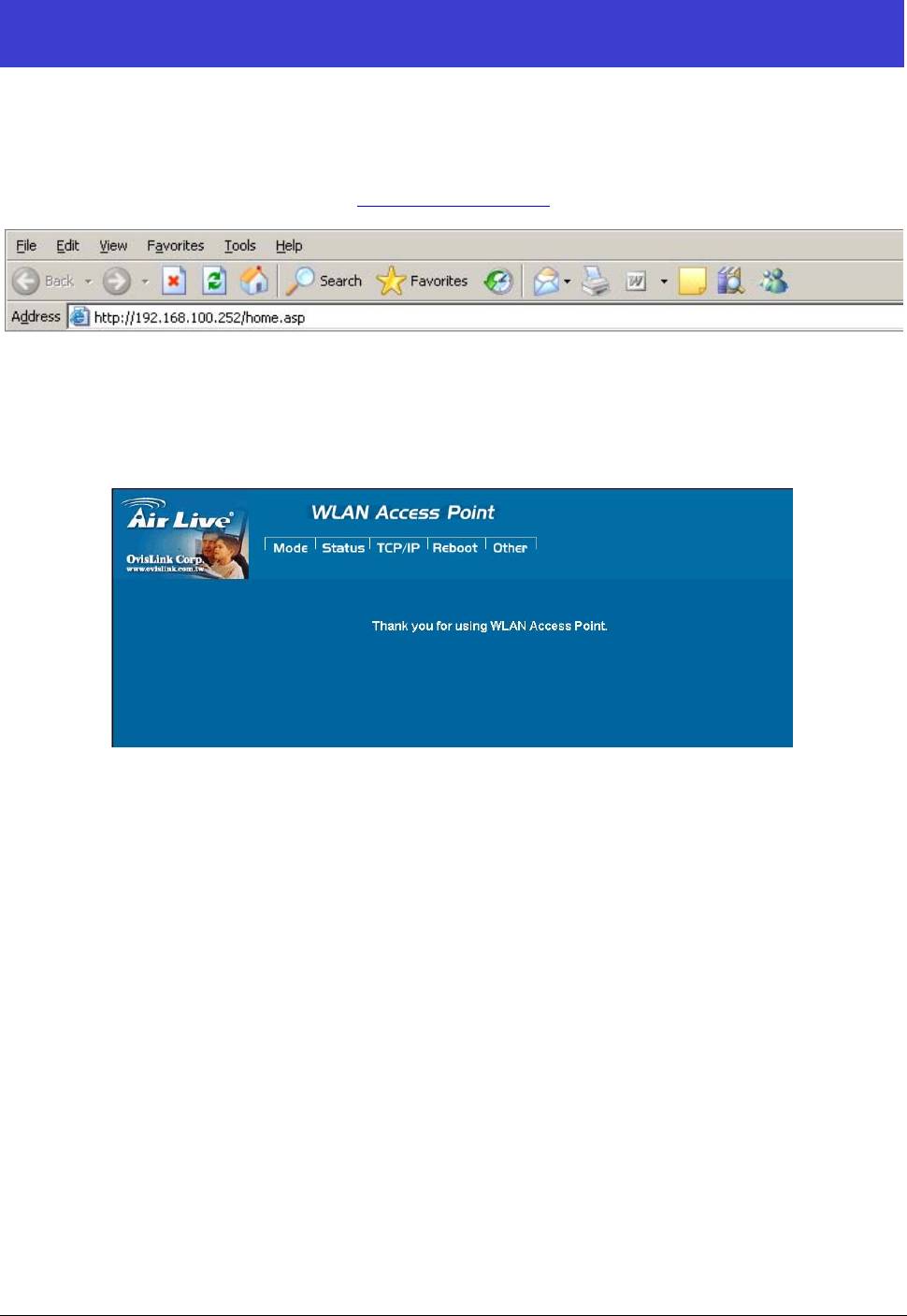
17 AirLive WL-5470POE User’s Manual
Configuration
1. Start your computer. Connect an Ethernet cable between your computer and the Wireless Access Point.
2. Make sure your wired station is set to the same subnet as the Wireless Access Point, i.e. 192.168.100.X
3. Start your WEB browser. In the Address box, enter the following:
http://192.168.100.252/
The configuration menu is divided into five categories:
Mode, Status, TCP/IP, Reboot and Other.
Click on the desired setup item to expand the page in the main navigation page. The setup pages
covered in this utility are described below.
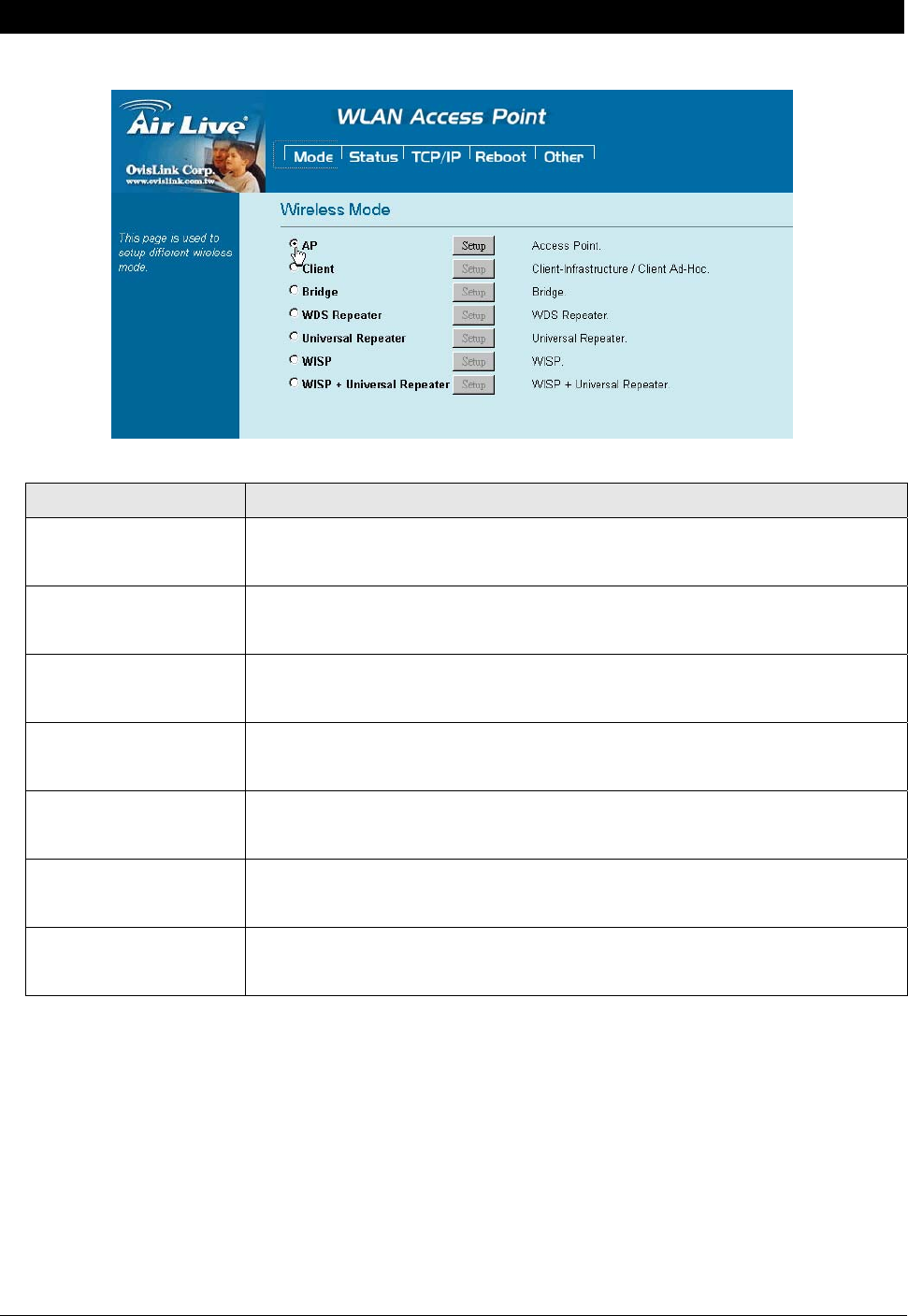
18 AirLive WL-5470POE User’s Manual
Mode
You can choose and setup different wireless mode for detail configurations
Wireless Mode
AP Select the AP and press Setup button for Wireless AP mode configuration.
Client Select the Client and press Setup button for Wireless Client mode
configuration.
Bridge Select the Bridge and press Setup button for Wireless Bridge mode
configuration.
WDS Repeater Select the WDS Repeater and press Setup button for Wireless WDS Repeater
mode configuration.
Universal Repeater Select the Universal Repeater and press Setup button for Wireless Universal
repeater mode configuration.
WISP Select the WISP and press Setup button for WISP (Client Router) mode
configuration.
WISP + Universal
Repeater
Select the WISP + Universal Repeater and press Setup button for WISP
+ Universal Repeater mode configuration.
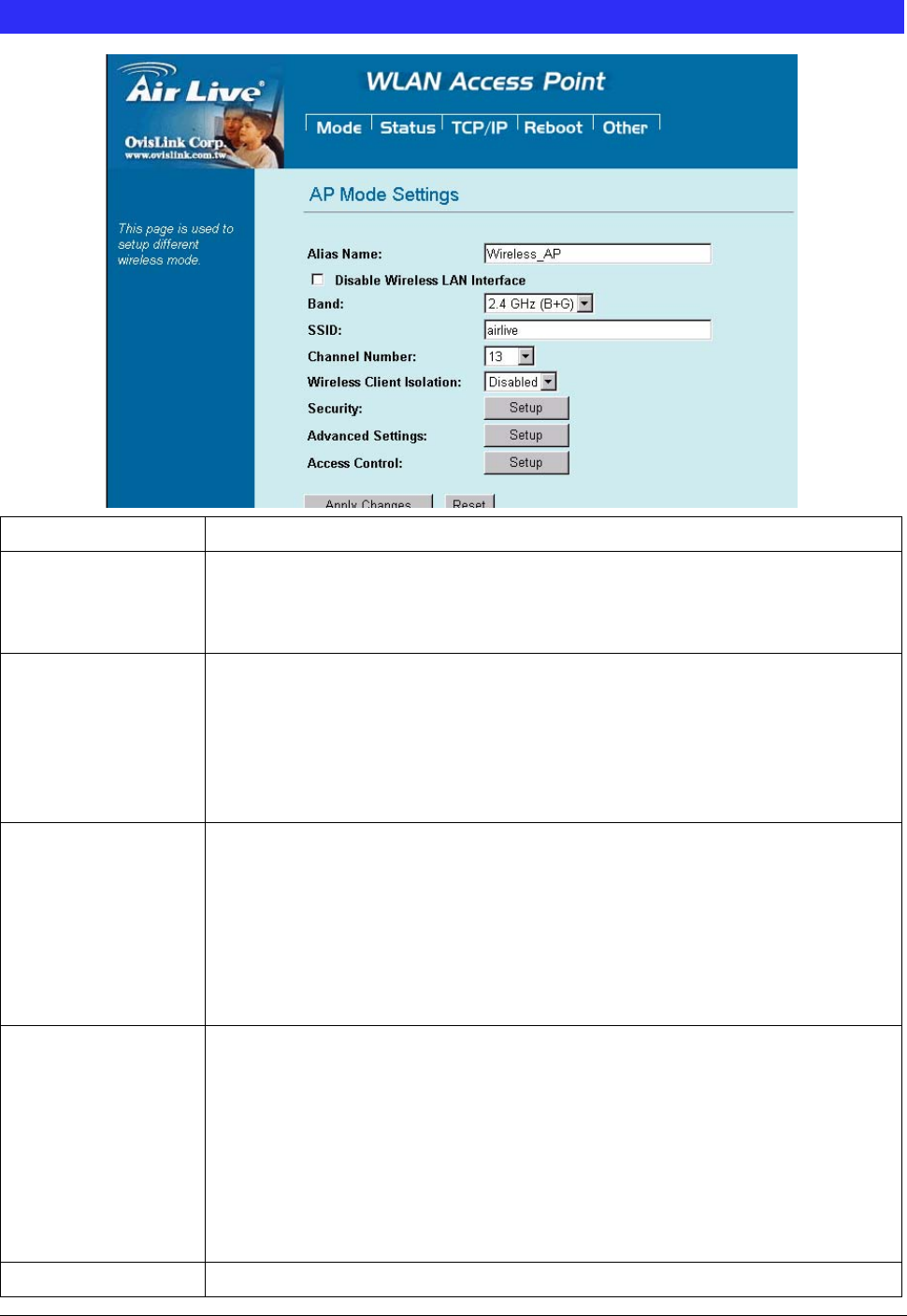
19 AirLive WL-5470POE User’s Manual
AP Mode Setting
Alias Name You can set the alias name for this device. Limited not exceed 32 characters.
Disable Wireless
LAN Interface
Check the box to disable the Wireless LAN Interface, by so doing; you won’t be able
to make wireless connection with this Access Point in your located network. In other
words, this device will not be visible by any wireless station.
Band You can choose one mode of the following you need.
~ 2.4GHz (B): 802.11b supported rate only.
~ 2.4GHz (G): 802.11g supported rate only.
~ 2.4GHz (B+G): 802.11b supported rate and 802.11g supported rate. The default
is 2.4GHz (B+G) mode.
SSID The SSID differentiates one WLAN from another; therefore, all access points and all
devices attempting to connect to a specific WLAN must use the same SSID. It is
case-sensitive and must not exceed 32 characters.
A
device will not be permitted
to join the BSS unless it can provide the unique SSID. An SSID is also referred to as
a network name because essentially it is a name that identifies a wireless network.
The default SSID is airlive.
Channel Number Allow user to set the channel manually or automatically.
If set channel manually, just select the channel you want to specify.
If “Auto” is selected, user can set the channel range to have Wireless Access Point
automatically survey and choose the channel with best situation for communication.
The number of channels supported depends on the region of this Access Point.
A
ll
stations communicating with the Access Point must use the same channel.
The default channel is 13.
Wireless Client
Allow user to set the function Enabled or Disabled.
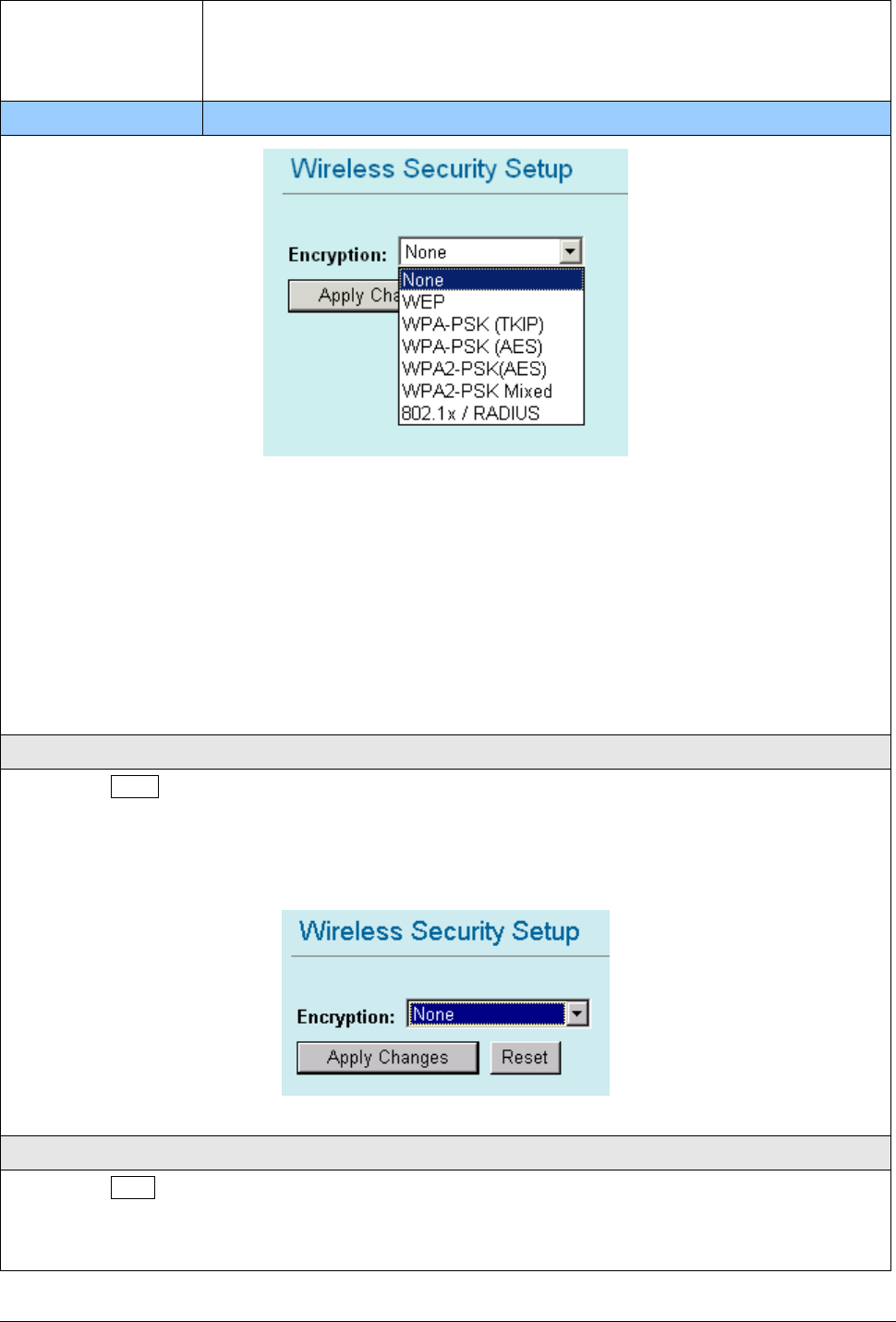
20 AirLive WL-5470POE User’s Manual
Isolation By the function, all wireless clients can't mutual link, but wireless client still link with
LAN port adapter.
The default value is Disabled.
Security Press the setup button for detail configurations
To provide a certain level of security, the IEEE 802.11 standard has defined two types of authentication
methods: Open System or Shared Key. And WL-5470POE also support other wireless authentication and
encryption methods for enhance your wireless network.
With Open System authentication, a wireless PC can join any network and receive any messages that are
not encrypted. With Shared Key authentication, only those PCs that possess the correct authentication key
can join the network. By default, IEEE 802.11 wireless devices operate in an Open System network and
None data encryption. If you want secure your wireless network, you need to setup wireless security related
function to enable security network.
None
Encryption: None (Encryption is set to None by default.)
If the Access Point is using Encryption None, then the wireless adapter will need to be set to the same
authentication mode.
WEP
Encryption: WEP
If selected WEP encryption, you must set WEP key value:
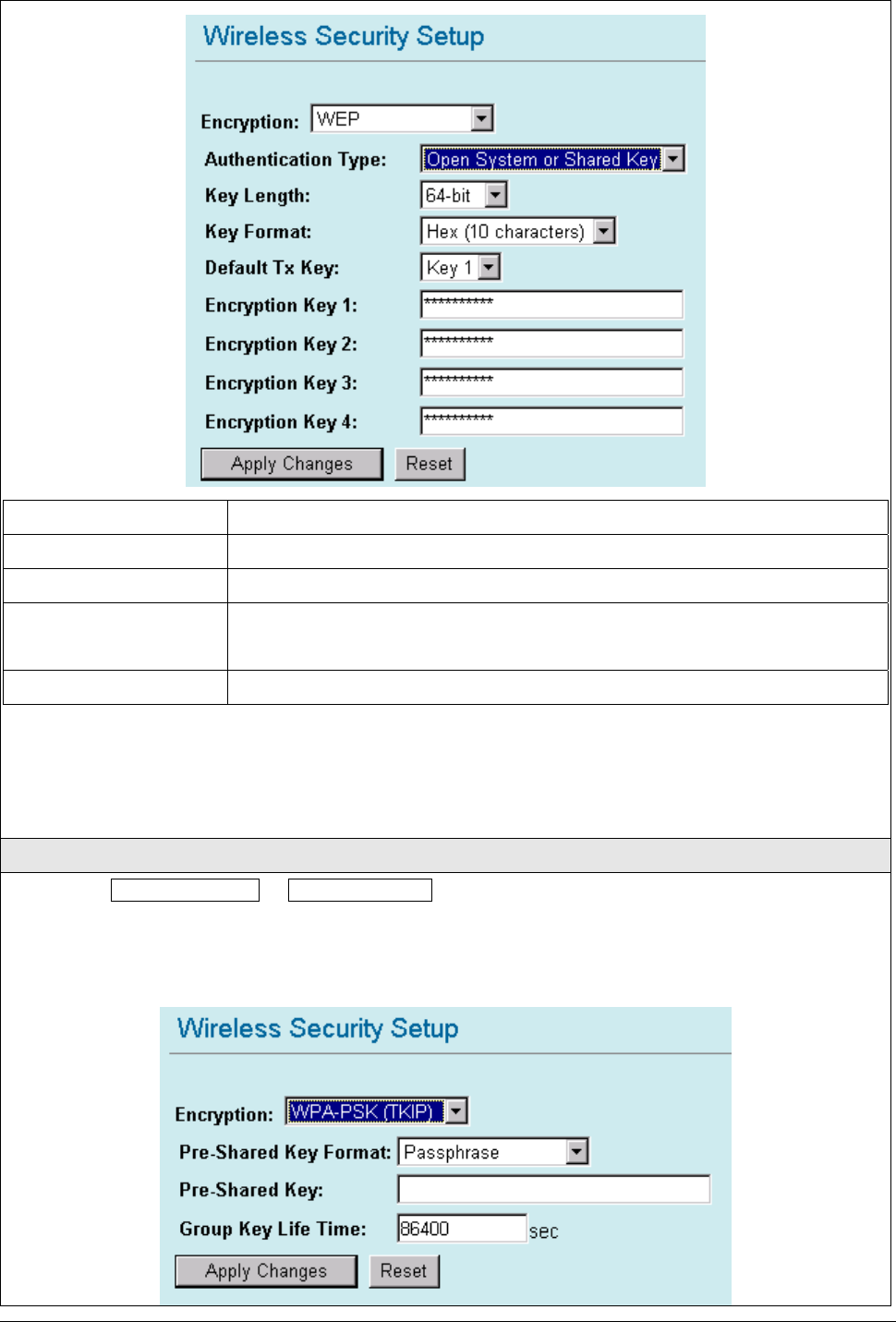
21 AirLive WL-5470POE User’s Manual
Encryption WEP
Authentication Type You can select Open System or Shared Key type for authentication.
Key Length You can set 64bit or 128bit Encryption.
Key Format Select ASCII if you are using ASCII characters (case-sensitive).
Select HEX if you are using hexadecimal numbers (0-9, or A-F).
Default TX Key You can enter 4 different Encryption Key and select one key to use as default.
10 hexadecimal digits or 5 ASCII characters are needed if 64-bit WEP is used;
26 hexadecimal digits or 13 ASCII characters are needed if 128-bit WEP is used.
Shared Key is used when both the sender and the recipient share a secret key. So you can choose Open
system, or one Shared Key authentication method.
WPA-PSK
Encryption: WPA-PSK (TKIP) or WPA-PSK (AES)
Wi-Fi Protected Access (WPA) with Pre-Shared Key (PSK) provides better security than WEP keys. It does
not require a RADIUS server in order to provide association authentication, but you do have to enter a shared
key for the authentication purpose. The encryption key is generated automatically and dynamically.
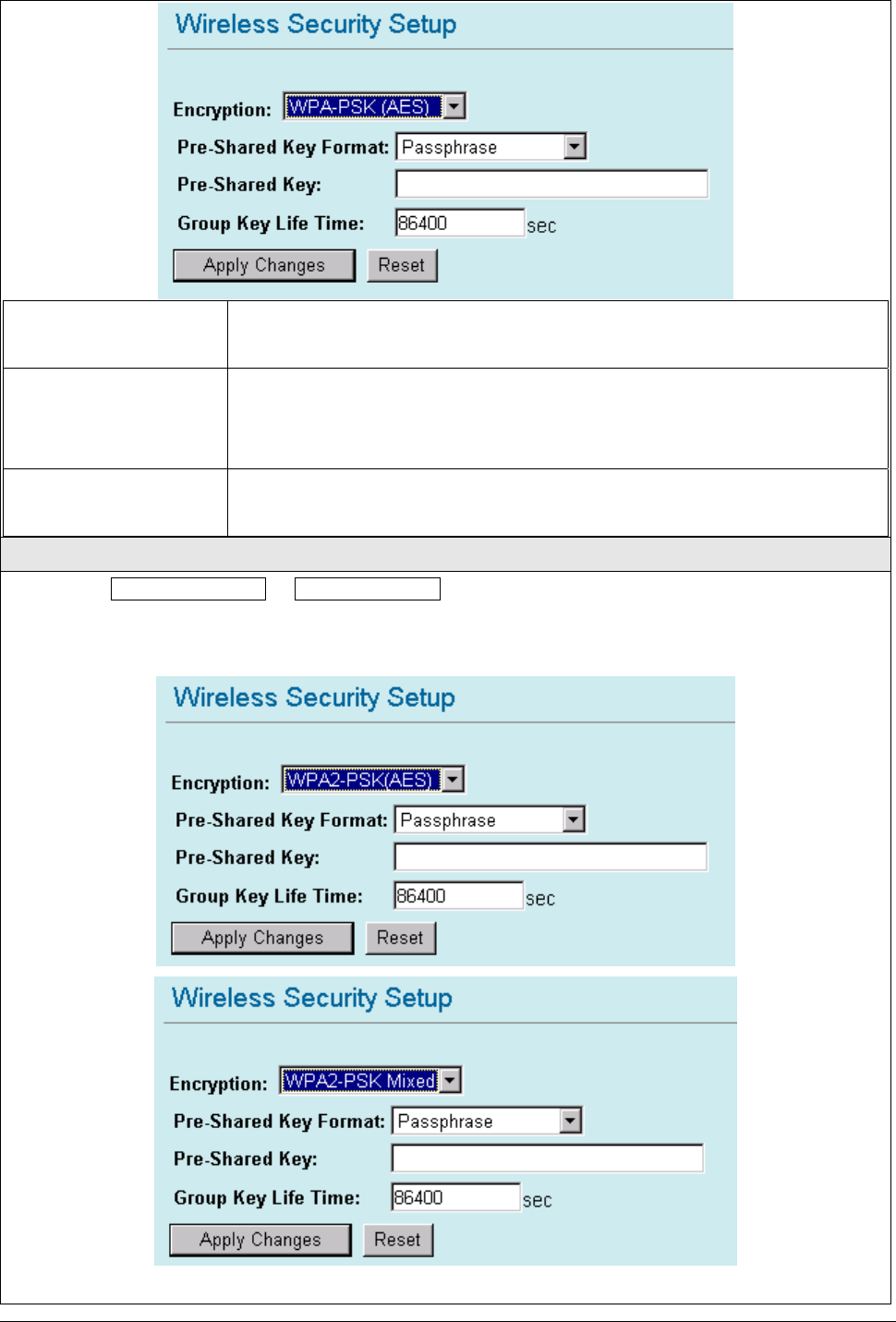
22 AirLive WL-5470POE User’s Manual
Encryption You can select WPA-PSK (TKIP) or WPA-PSK (AES) method for data
encryption.
Pre-shared Key There are two formats for choice to set the Pre-shared key, i.e. Passphrase and
Hex. If Hex is selected, users will have to enter a 64 characters string. For easier
configuration, the Passphrase (at least 8 characters) format is recommended.
Group Key Life Time Enter the number of seconds that will elapse before the group key change
automatically. The default is 86400 seconds.
WPA2-PSK
Encryption: WPA2-PSK (AES) or WPA-PSK Mixed
WPA2-PSK authentication method is almost like WPA-PSK, You can choose the Pre-Shared Key format and
enter the Pre-shared key,
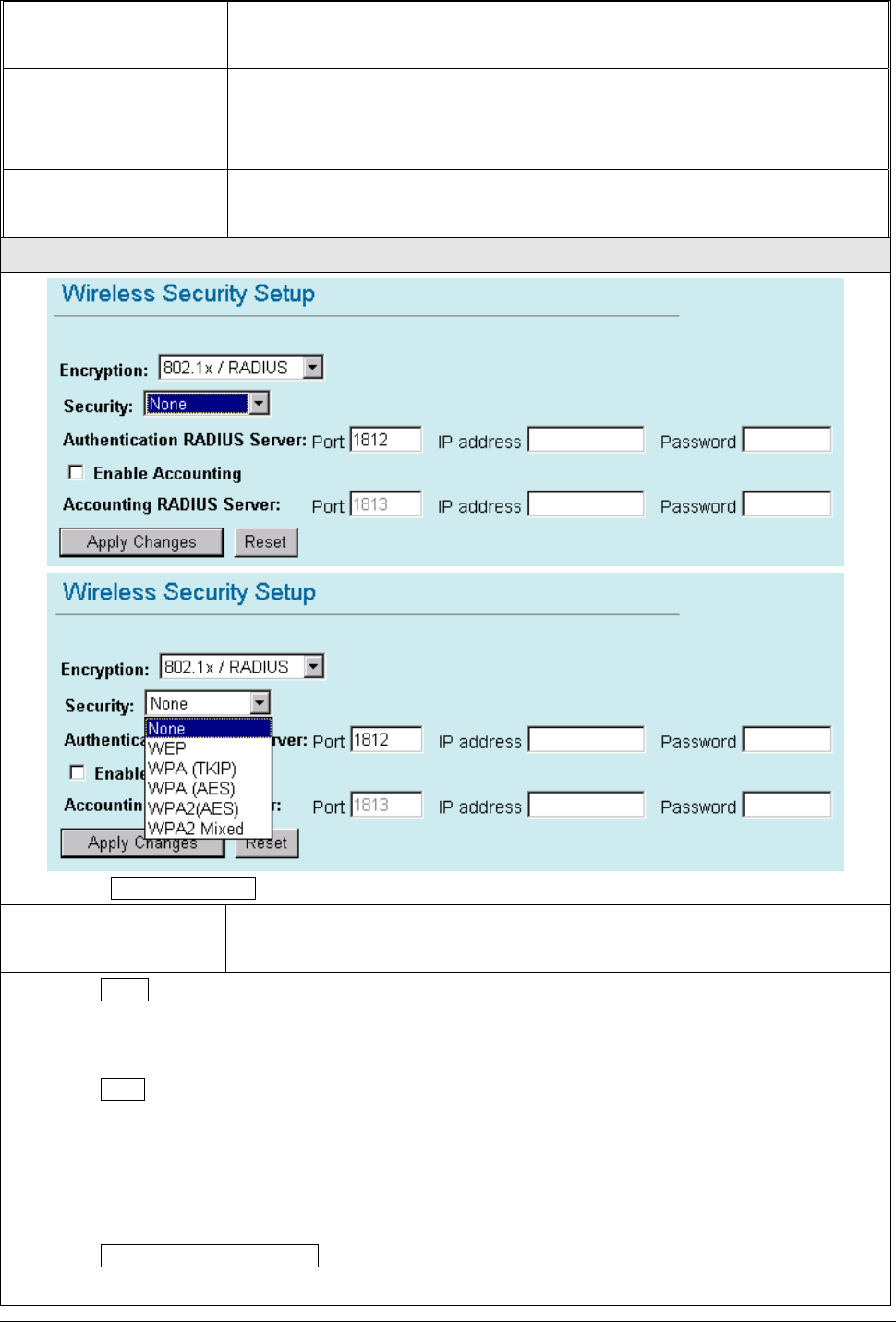
23 AirLive WL-5470POE User’s Manual
Encryption You can select WPA2-PSK (AES) or WPA2-PSK Mixed method for data
encryption
Pre-shared Key There are two formats for choice to set the Pre-shared key, i.e. Passphrase and
Hex. If Hex is selected, users will have to enter a 64 characters string. For easier
configuration, the Passphrase (at least 8 characters) format is recommended.
Group Key Life Time Enter the number of seconds that will elapse before the group key change
automatically. The default is 86400 seconds.
802.1x / RADIUS
Encryption: 802.1x / RADIUS
security You can select None, WEP, WPA (TKIP), WPA (AES), WPA2 (AES), WPA2
Mixed method for data encryption.
Encryption: None
No data encryption and Use 802.1x Authentication is disable.
Encryption: WEP
802.1x Authentication is enabled and the RADIUS Server will proceed to check the 802.1x Authentication,
and make the RADIUS server to issue the WEP key dynamically.
You can select WEP 64bits or WEP 128bits for data encryption.
Encryption: WPA (TKIP) / WPA (AES)
WPA-RADIUS authentication use WPA (Wi-Fi Protect Access) data encryption for 802.1x authentication.
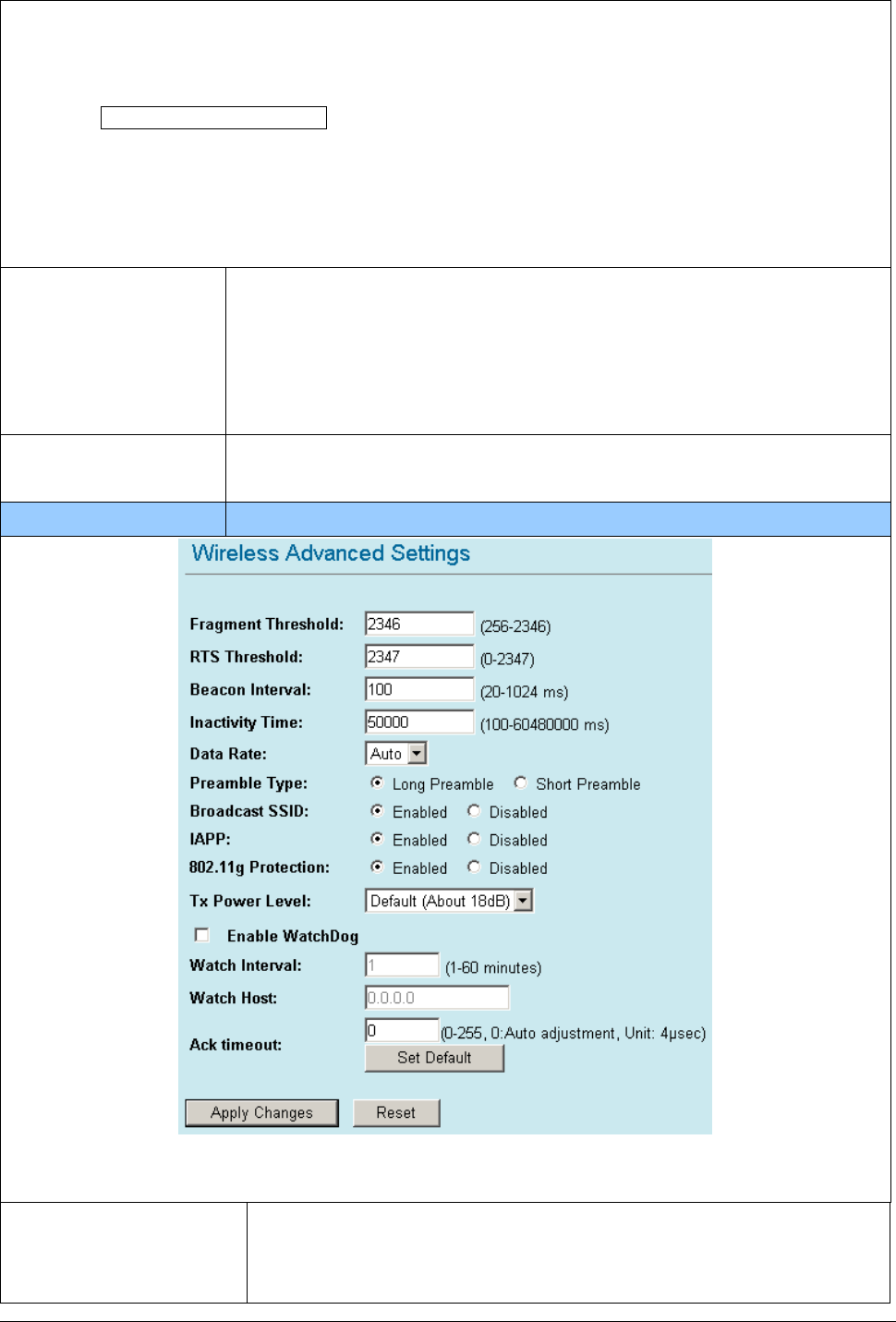
24 AirLive WL-5470POE User’s Manual
WPA is an encryption standard proposed by WiFi for advance protection by utilizing a password key (TKIP)
or certificate. It is more secure than WEP encryption.
Encryption: WPA2-AES / WPA2-Mixed
The two most important features beyond WPA to become standardized through 802.11i/WPA2 are:
pre-authentication, which enables secure fast roaming without noticeable signal latency. Pre-authentication
provides a way to establish a PMK security association before a client associates. The advantage is that the
client reduces the time that it's disconnected to the network.
Authentication RADIUS
Server
Enter the RADIUS Server IP address and Password provided by your ISP.
Port: Enter the RADIUS Server’s port number provided by your ISP. The default
is 1812.
IP Address: Enter the RADIUS Server’s IP Address provided by your ISP.
Password: Enter the password that the AP shares with the RADIUS Server.
Accounting RADIUS
Server
Enter the Accounting RADIUS Server IP address and Password provided by your
ISP
Advanced Settings Press the setup button for detail configurations
It is not recommended that settings in this page to be changed unless advanced users want to change to
meet their wireless environment for optimal performance.
Fragment Threshold Fragmentation mechanism is used for improving the efficiency
when high traffic flows along in the wireless network. If your
802.11g Wireless LAN PC Card often transmit large files in wireless